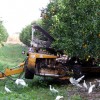 Mechanization has been the hallmark of American agriculture. Nearly 100 percent of the agronomic crops grown in the United States are plowed, planted, and harvested with mechanical equipment. Mechanical harvesting equipment for sweet oranges has been studied extensively since the 1970s and during the 2005/06 harvest season, trunk and canopy shakers harvested more than 36,000 acres of Florida citrus. Mechanically harvested citrus acreage, however, has decreased significantly since 2005. During the 2012/13 season, less than 9,000 acres were mechanically harvested (FDOC 2013). Nevertheless, development and adoption of mechanical harvesting technology is important to the long-term economic sustainability of the Florida orange juice processing industry. This 5-page fact sheet describing canopy shakerswas written by F.M. Roka, R.J. Ehsani, S.H. Futch, and B.R. Hyman, and published by the UF Department of Food and Resource Economics, August 2014.
Mechanization has been the hallmark of American agriculture. Nearly 100 percent of the agronomic crops grown in the United States are plowed, planted, and harvested with mechanical equipment. Mechanical harvesting equipment for sweet oranges has been studied extensively since the 1970s and during the 2005/06 harvest season, trunk and canopy shakers harvested more than 36,000 acres of Florida citrus. Mechanically harvested citrus acreage, however, has decreased significantly since 2005. During the 2012/13 season, less than 9,000 acres were mechanically harvested (FDOC 2013). Nevertheless, development and adoption of mechanical harvesting technology is important to the long-term economic sustainability of the Florida orange juice processing industry. This 5-page fact sheet describing canopy shakerswas written by F.M. Roka, R.J. Ehsani, S.H. Futch, and B.R. Hyman, and published by the UF Department of Food and Resource Economics, August 2014.
http://edis.ifas.ufl.edu/fe951
Tag: Barbara R. Hyman
Citrus Mechanical Harvesting Systems–Trunk Shakers
 While citrus growers are rightfully concerned about restoring the health of their HLB-infected trees, more study and consideration should be given to mechanical harvesting. The costs to grow and harvest citrus have been escalating significantly since 2006, and the cost savings potential from mechanical harvesting technologies can help Florida growers remain economically viable. This 4-page fact sheet was written by F.M. Roka, R.J. Ehsani, S.H. Futch, and B.R. Hyman, and published by the UF Department of Food and Resource Economics, August 2014.
While citrus growers are rightfully concerned about restoring the health of their HLB-infected trees, more study and consideration should be given to mechanical harvesting. The costs to grow and harvest citrus have been escalating significantly since 2006, and the cost savings potential from mechanical harvesting technologies can help Florida growers remain economically viable. This 4-page fact sheet was written by F.M. Roka, R.J. Ehsani, S.H. Futch, and B.R. Hyman, and published by the UF Department of Food and Resource Economics, August 2014.
http://edis.ifas.ufl.edu/fe950
Measuring Productivity of Citrus Hand Harvesters and Assessing Implications on Harvest Costs and Mechanical Harvesting Developments (FE933)
 Existing mechanical harvesters recover 70 to 95 percent of the available fruit crop. While changes can be made to increase fruit recovery percentages, mechanical systems will never equal the fruit recovery percentages from hand-harvesting crews, much less capture 100 percent of the available fruit. Whether or not to glean (to use manual labor to collect fruit not harvested by the machine) will remain an important question that growers will have to face with every block they choose to mechanically harvest. This study incorporated field harvesting data and developed a model that predicted the extent to which labor productivity would be affected by decreasing the number of oranges available for harvesting by manual labor. Given current market prices of fruit, recovery percentage of crops harvested using mechanical harvesting equipment can improve up to 99 percent and gleaning will remain a profitable activity.
Existing mechanical harvesters recover 70 to 95 percent of the available fruit crop. While changes can be made to increase fruit recovery percentages, mechanical systems will never equal the fruit recovery percentages from hand-harvesting crews, much less capture 100 percent of the available fruit. Whether or not to glean (to use manual labor to collect fruit not harvested by the machine) will remain an important question that growers will have to face with every block they choose to mechanically harvest. This study incorporated field harvesting data and developed a model that predicted the extent to which labor productivity would be affected by decreasing the number of oranges available for harvesting by manual labor. Given current market prices of fruit, recovery percentage of crops harvested using mechanical harvesting equipment can improve up to 99 percent and gleaning will remain a profitable activity.
This 6-page fact sheet was written by Fritz M. Roka and Barbara R. Hyman, and published by the UF Department of Food and Resource Economics, May 2013.
http://edis.ifas.ufl.edu/fe933